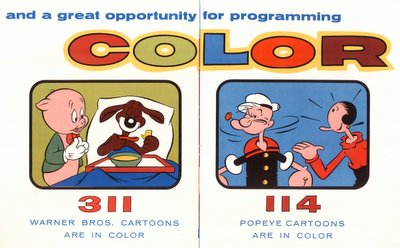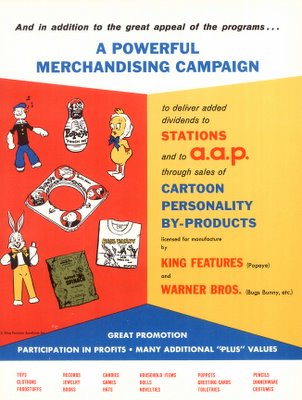



Cartoons On TV --- Part 2
The sale of the Warner Bros. pre-49 library to Associated Artists included 850 features, plus 1,500 shorts and cartoons, and the price was $21 million. That may have seemed like a lot in those days, and God knows they needed the money, but in hindsight, this was an act of pure lunacy on Warner’s part. The cartoons alone were worth many times the total price, as it turned out. We're too young to recall the initial launch of these packages, but by the late fifties, the Greenbriar was on board for Popeye’s every sailing, and those WB cartoons, with their distinctive AAP openings (where you’d get to hear the opening fanfare twice), were ubiquitous on every channel hauled in on our "tenna roter". We particularly recall a daily ritual out of WLOS in Asheville, NC, which began at 7:00 AM, and continued with two solid hours of non-stop WB’s and Popeyes, interrupted only by the weather reports. It didn’t take long to become cartoon literate, as we learned to recognize the pedigree of each short by their opening titles. The good Popeyes were the ones with the ship’s doors, opening and closing to reveal the credits (we always liked that sound they made … still do). The Warner groups were less predictable, as there were certain rogue distributors out there (at least they seemed roguish then) who would remove the studio openings altogether and replace them with ugly cards crediting "Sunset", or "Guild" Films. We’d never heard of those guys, and we could tell they’d not really made these cartoons. Those drawings of Porky holding a rifle, that peculiar dog, and a weirdly distorted Daffy Duck were a stench in the nostrils of many young viewers, including myself, but the cartoons were good, as they were actually the B/W Warner titles not included in the AAP group. It seemed every station had a Popeye show. That sailor man was an absolute sensation when he first hit the airwaves. We had kid shows down here that would sandwich him in between the live studio spots with a kid host and his studio full of moppets (invariably Cub Scout or Brownie troops --- I was briefly a Cub myself, but was drummed out for cowardice). Those Popeyes, even the Fleischers, could get a little tedious when you were seeing six or seven in a row, eventually reaching a point where you’d look at a minute or so, then yell, "Just eat the damn spinach and get on with it!" At some point during every broadcast, those kids in the studio would get their treat bags, then you’d sit for an interminable recitation of every merchant’s name who’d "donated" the useless, and/or tooth-rotting, bric-a-brac within those sacks. One thing about these pages from AAP’s campaign manual --- the emphasis on color cartoons. How many households even had color sets then? I know my family didn’t, and wouldn’t, until 1966. In the meantime, I wonder how many stations broadcast these cartoons in color. It was cheaper for the locals to use B/W prints, and I’d guess that’s what most of them did. Of course, the station managers eventually went looking for "fresh" cartoons, and that’s when we got those dreadful Dick Tracy and made-for-TV Mr. Magoos. They were five minutes long (to the second!) and really sucked, if you’ll excuse the vulgarism. They were an insult to every thinking child in the audience. The offense inflicted by their presence on the airwaves could only be surpassed by the arrival of Astro Boy around 1964. One station manager even acknowledged the unworthiness of that character in a reply to one of my indignant letters sent back in the late sixties (my first letter, at the age of six, included detailed suggestions for a revamping of the Saturday morning schedule, and I’m still waiting for a reply to that one). All this action on TV screens made theatrical cartoons seem superfluous, of course, and that's where the theatre exhibitors got up in arms. In tomorrow’s entry, they fight back!
6 Comments:
That was a really interesting and fun post!! I thought I was the only kid to watch cartoons and tell which ones were good by the opening titles, and that was in the late 80's early 90's when they still showed the occasional Looney Tune on Saturday mornings. I can't believe how lucky you were to get 2 hours of cartoons!! Great blog!!
Heh, I grew up in the early '80s when the AAP library still had a spot on the UHF drive, as well as through Superstation WTBS. Never realized just how the business end was on those things until only a few years ago when I started to figure it out. I miss those days when they were still on terrestrial television (now being allocated to digital cable and/or home video).
Intresting how companies like AAP and U.M. & M. TV Corp didn't last too long for a while, yet their names lived on through the aquisitions from other companies that took over from the 1960's onward.
Your post reminds me of the time I spent watching Warner Bros. cartoons on local television -- and how confusing it was to me that the animation on the pre-1948 Looney Tunes always seemed so poor in comparison to other Warner Bros. cartoons from the same era (which were part of the AAP package on another local station).
It's funny -- I wouldn't wish the world of old, faded Eastmancolor prints and traced-and-refilmed color Looney Tunes on anyone -- but I sure have fond memories of seeing this stuff when I was growing up.
AAP was one of those odd memories from my childhood. I had no idea who those guys were but that lowercase aap logo seemed somewhat sinister to me. Sort of like how sinister the Screen Gems logo and the weird music behind it was, and the odd eggbeater logo (god I forget which company it was) that would be in front of all the Gerry Anderson puppet shows like Thunderbirds.
It's only recently that we're seeing the WB cartoons with their original title cards and without those damn aap logos. Just like Chris said, it's weird how those old syndication companies live on long after they're dead, by dint of all those TV syndication prints floating around.
Jerry Beck's blog directed me to your fine site, which I have added to my blogroll.
You nailed it right on the head with this post. Even back in my Snot-Nose Days, I could tell a quality cartoon from a cheap piece of crap.
The pre-1950 Warner Brothers cartoons were the best. The old Popeyes - Max and Dave Fleischer's work - before Paramount got hold of the studio and started churning out garbage.
And I remember how disappointed I was when those Dick Tracy 'toons came out. Horrible. I mean - Joe Jitsu? Yeef. Pretty much every adaptation of a popular comic strip character was lousy in those days.
Ah, well. Now, at least, we can fill our cabinets with DVD's with good-quality prints of those old classics.
In a way, the whole "a.a.p." thing is a commentary (as if we need yet another one) on how little value was placed on cartoons. Associated Artists also got the Warner features for TV, yet you never saw one of those begin with the "a.a.p" logo on TV after the company was acquired by United Artists Television. Apparently it just wasn't worth the effort to remove and replace the old opening from all those silly cartoons. Who knew that a long-defunct company from the waning days of TV's golden age would keep on heralding some of the world's most beloved animated treasures into the 1990's?
Now, would anyone like to hazard a guess as to a.a.p.'s connection with "The Adventures of Superman"?
Post a Comment
<< Home